An Investigation of Recharging Groundwater Levels through River Ponding: New Strategy for Water Management in Sutlej River
Abstract
1. Introduction
2. Case Study and Data Description
3. Adopted Methodology
3.1. Urbanization Rate
3.2. Backwater Effect
3.3. Setting up of MODFLOW Model
3.3.1. Model Calibration and Validation
3.3.2. Model Application (Scenario Modeling)
4. Application Results and Analysis
4.1. Water Table Decline Rate
4.2. Urbanization Rate
4.3. Backwater Effect
4.4. Results of Scenario 1 (Current Situation)
- The water table is expected to decline at an average rate of 201 mm per year.
- The groundwater abstraction in 2014, 27.45 million gallons per day (MGD) against a recharge of 22.45 MGD, will increase to 33 MGD in 2034.
4.5. Results of Scenario 2 (Ponding up to Elevations of 148, 149, 150, and 151 m)
- i.
- The elevation area capacity curve for the proposed ponding through the dam is shown in Figure 13. The contribution/volume of groundwater recharge with different dam ponding elevations (148–151 m) is presented in Figure 14. The groundwater model results show that upon ponding the river from elevations of 148 to 151 m, the lake area varies from 26.8 to 37.6 km2, and its capacity varies from 26.5 to 153 Mm3, contributing a base-year recharge of 7.91 to 12.5 MGD, respectively.
- ii.
- The results of groundwater modeling for a dam ponding elevation of 148 m, in the form of groundwater contour maps after 1 year and 20 years of ponding/the simulation period, are shown in Figure 15 and Figure 16, respectively. Meanwhile, the results of groundwater modeling for a dam ponding elevation of 151 m, in the form of groundwater contour maps after 1 year and 20 years of ponding/the simulation period, are shown in Figure 17 and Figure 18.
- iii.
- The results of groundwater modeling show that the lateral extent of recharge via ponding will benefit an area of 27,650 to 32,100 acres, and the maximum water table will rise by 2 m and 5 m adjacent to the river in the case of ponding up to elevations 148 m and 151 m, respectively.
- iv.
- The results of the model (Figure 19) depict that the average water table decline in the study area is expected to be reduced from 201 to 151 mm/year (ponding at EL of 148 m) and 95 mm/year (ponding at EL of 151 m).
- v.
- The comparison of cumulative recharge and abstraction, as plotted in Figure 20 and Figure 21, revealed that for areas that benefitted from dam recharge, the groundwater abstraction rate will remain sustainable for more than 50 years for all the cases of ponding and for the overall study area; moreover, the cumulative abstraction will remain sustainable for 7, 8.3, 10.5, and 12.3 years in the case of ponding in the river up to elevations of 148, 149, 150, and 151 m, respectively. After that, some other recharging mechanism would be required.
4.6. Discussion
5. Conclusions
- The historical water table data of the study area revealed that the mean water table elevation had declined 0.97 m in the previous seven (07) years, which is equivalent to 139 mm/year. Though the decline rate is not particularly excessive, it still represents the alarming situation of the study area, where the per capita groundwater resources are reducing. Furthermore, the population, and thus, demand is increasing.
- The results of urbanization classification showed that the urban area has been increasing at a rate of 1.1 % per year for the last 22 years, whereas this increase has been more pronounced, i.e., 1.62% per year, in the last 8 years. Hence, the above factors reinforce each other, i.e., the increasing population and urbanization contribute to less recharge and more abstraction and ultimately result in an enhanced decline rate of the groundwater table.
- The results of the HEC-RAS model show that for ponding up to an elevation of 148 m (4 m high dam), the backwater effect goes up to about 25 km upstream of the dam with a lake area of 26.87 km2. Based upon the discharge and stage data, it is observed that the average lake elevation remains below a 146 m elevation most of the time, which implies that about a 23 km2 area will be inundated.
- The results of the groundwater model depict that the lateral extent of recharge via ponding will benefit an area of 27,650 to 32,100 acres, and the maximum water table will rise by 2 m and 5 m adjacent to the river in the case of ponding up to elevations of 148 m and 151 m, respectively.
- The results of the model scenarios depict that the decline rate in the overall study area is expected to be reduced from 201 mm/year (no ponding) to 151 and 95 mm/year (ponding at elevations of 148 and 151m, respectively), which shows a promising contribution of ponding action to groundwater recharge.
- The mass balance results of groundwater modeling show that for areas that benefitted from the dam, the groundwater abstraction rate will remain sustainable for more than 50 years, promoting environmental balance in the study area.
Author Contributions
Funding
Institutional Review Board Statement
Informed Consent Statement
Data Availability Statement
Acknowledgments
Conflicts of Interest
References
- Wada, Y. Modeling Groundwater Depletion at Regional and Global Scales: Present State and Future Prospects. Surv. Geophys. 2015, 37, 419–451. [Google Scholar] [CrossRef]
- Morsy, K.M.; Morsy, A.M.; Hassan, A.E. Groundwater sustainability: Opportunity out of threat. Groundw. Sustain. Dev. 2018, 7, 277–285. [Google Scholar] [CrossRef]
- Pokhrel, Y.N.; Fan, Y.; Miguez-Macho, G.; Yeh, P.J.-F.; Han, S.-C. The role of groundwater in the Amazon water cycle: 3. Influence on terrestrial water storage computations and comparison with GRACE. J. Geophys. Res. Atmos. 2013, 118, 3233–3244. [Google Scholar] [CrossRef]
- Arafa, N.A.; Salem, Z.E.-S.; Ghorab, M.A.; Soliman, S.A.; Abdeldayem, A.L.; Moustafa, Y.M.; Ghazala, H.H. Evaluation of Groundwater Sensitivity to Pollution Using GIS-Based Modified DRASTIC-LU Model for Sustainable Development in the Nile Delta Region. Sustainability 2022, 14, 14699. [Google Scholar] [CrossRef]
- Elshall, A.S.; Arik, A.D.; El-Kadi, A.I.; Pierce, S.; Ye, M.; Burnett, K.M.; Wada, C.A.; Bremer, L.L.; Chun, G. Groundwater sustainability: A review of the interactions between science and policy. Environ. Res. Lett. 2020, 15, 93004. [Google Scholar] [CrossRef]
- Wada, Y.; Van Beek, L.P.H.; Bierkens, M.F.P. Nonsustainable groundwater sustaining irrigation: A global assessment. Water Resour. Res. 2012, 48, W00L06. [Google Scholar] [CrossRef]
- Qureshi, A.S.; Gill, M.A.; Sarwar, A. Sustainable groundwater management in Pakistan: Challenges and pportunities. Irrig. Drain. 2010, 59, 107–116. [Google Scholar] [CrossRef]
- Qureshi, A.S. Water management in the Indus basin in Pakistan: Challenges and opportunities. Mt. Res. Dev. 2011, 31, 252. [Google Scholar] [CrossRef]
- Awadh, S.M.; Al-Mimar, H.; Yaseen, Z.M. Groundwater availability and water demand sustainability over the upper mega aquifers of Arabian Peninsula and west region of Iraq. Environ. Dev. Sustain. 2020, 23, 1–21. [Google Scholar] [CrossRef]
- Tao, H.; Hameed, M.M.; Marhoon, H.A.; Zounemat-Kermani, M.; Salim, H.; Sungwon, K.; Sulaiman, S.O.; Tan, M.L.; Sa’adi, Z.; Mehr, A.D. Groundwater Level Prediction using Machine Learning Models: A Comprehensive Review. Neurocomputing 2022, 489, 271–308. [Google Scholar] [CrossRef]
- Paul, S. Impact of Proposed Rubber Dam in Mohananda River at Chapai Nawabganj District on Adjacent Groundwater. Master’s Thesis, Department of Water Resources Engineering, Bangladesh University of Engineering and Technology, Dhaka, Bangladesh, 2017. [Google Scholar]
- Irshad, K. Analysis of Ground Water Depletion and Its Impact on Water Quality in Lahore. Master of Sciences Thesis, University of Engineering and Technology, Lahore, Pakistan, 2018; pp. 1–65. [Google Scholar]
- Basharat, M.; Umair Ali, S.; Azhar, A.H. Spatial variation in irrigation demand and supply across canal commands in Punjab: A real integrated water resources management challenge. Water Policy 2013, 16, 397–421. [Google Scholar] [CrossRef]
- Dong, S.; Liu, B.; Liu, H.; Wang, S.; Wang, L. Impacts of groundwater recharge from rubber dams on the hydrogeological environment in Luoyang Basin, China. Sci. World J. 2014, 2014, 183457. [Google Scholar] [CrossRef] [PubMed]
- Liu, S.; Zhou, Y.; Luo, W.; Wang, F.; McClain, M.E.; Wang, X. A numerical assessment on the managed aquifer recharge to achieve sustainable groundwater development in Chaobai River area, Beijing, China. J. Hydrol. 2022, 613, 128392. [Google Scholar] [CrossRef]
- Singh, A. Long-term (44 Years) regional groundwater recharge estimation for agricultural sustainability. Nat. Resour. Res. 2022, 31, 301–314. [Google Scholar] [CrossRef]
- El Bouazzaoui, I.; Ait Brahim, Y.; El Khalki, E.M.; Najmi, A.; Bougadir, B. A Summary Analysis of Groundwater Vulnerability to Climate Variability and Anthropic Activities in the Haouz Region, Morocco. Sustainability 2022, 14, 14865. [Google Scholar] [CrossRef]
- World Water Assessment Programme. The United Nations World Water Development Report 3: Water in a Changing World; UNESCO: Paris, France; Earthscan: London, UK, 2009. [Google Scholar]
- Bierkens, M.F.P.; Wada, Y. Non-renewable groundwater use and groundwater depletion: A review. Environ. Res. Lett. 2019, 14, 63002. [Google Scholar] [CrossRef]
- Al-Amri, N.; Budiman, J.; Elfeki, A. Integrated Surface Water and Groundwater Modeling in Arid Environment, Al-Lusub Watershed, Saudi Arabia. Water 2022, 14, 3075. [Google Scholar] [CrossRef]
- Lehner, B.; Liermann, C.R.; Revenga, C.; Vörösmarty, C.; Fekete, B.; Crouzet, P.; Döll, P.; Endejan, M.; Frenken, K.; Magome, J. High-resolution mapping of the world’s reservoirs and dams for sustainable river-flow management. Front. Ecol. Environ. 2011, 9, 494–502. [Google Scholar] [CrossRef]
- Igboekwe, M.U.; Achi, N.J. Finite Difference Method of Modelling Groundwater Flow. J. Water Resour. Prot. 2011, 03, 192–198. [Google Scholar] [CrossRef]
- Trásy-Havril, T.; Szkolnikovics-Simon, S.; Mádl-Szőnyi, J. How Complex Groundwater Flow Systems Respond to Climate Change Induced Recharge Reduction? Water 2022, 14, 3026. [Google Scholar] [CrossRef]
- Ibáñez, J.; Gartzia, R.; Alcalá, F.J.; Martínez-Valderrama, J. The Importance of Prevention in Tackling Desertification: An Approach to Anticipate Risks of Degradation in Coastal Aquifers. Land 2022, 11, 1626. [Google Scholar] [CrossRef]
- Feng, W.; Zhong, M.; Lemoine, J.-M.; Biancale, R.; Hsu, H.-T.; Xia, J. Evaluation of groundwater depletion in North China using the Gravity Recovery and Climate Experiment (GRACE) data and ground-based measurements. Water Resour. Res. 2013, 49, 2110–2118. [Google Scholar] [CrossRef]
- Huang, Z.; Pan, Y.; Gong, H.; Yeh, P.J.-F.; Li, X.; Zhou, D.; Zhao, W. Subregional-scale groundwater depletion detected by GRACE for both shallow and deep aquifers in North China Plain. Geophys. Res. Lett. 2015, 42, 1791–1799. [Google Scholar] [CrossRef]
- Hu, Y.; Moiwo, J.P.; Yang, Y.; Han, S.; Yang, Y. Agricultural water-saving and sustainable groundwater management in Shijiazhuang Irrigation District, North China Plain. J. Hydrol. 2010, 393, 219–232. [Google Scholar] [CrossRef]
- Konikow, L.F.; Bredehoeft, J.D. Ground-water models cannot be validated. Adv. Water Resour. 1992, 15, 75–83. [Google Scholar] [CrossRef]
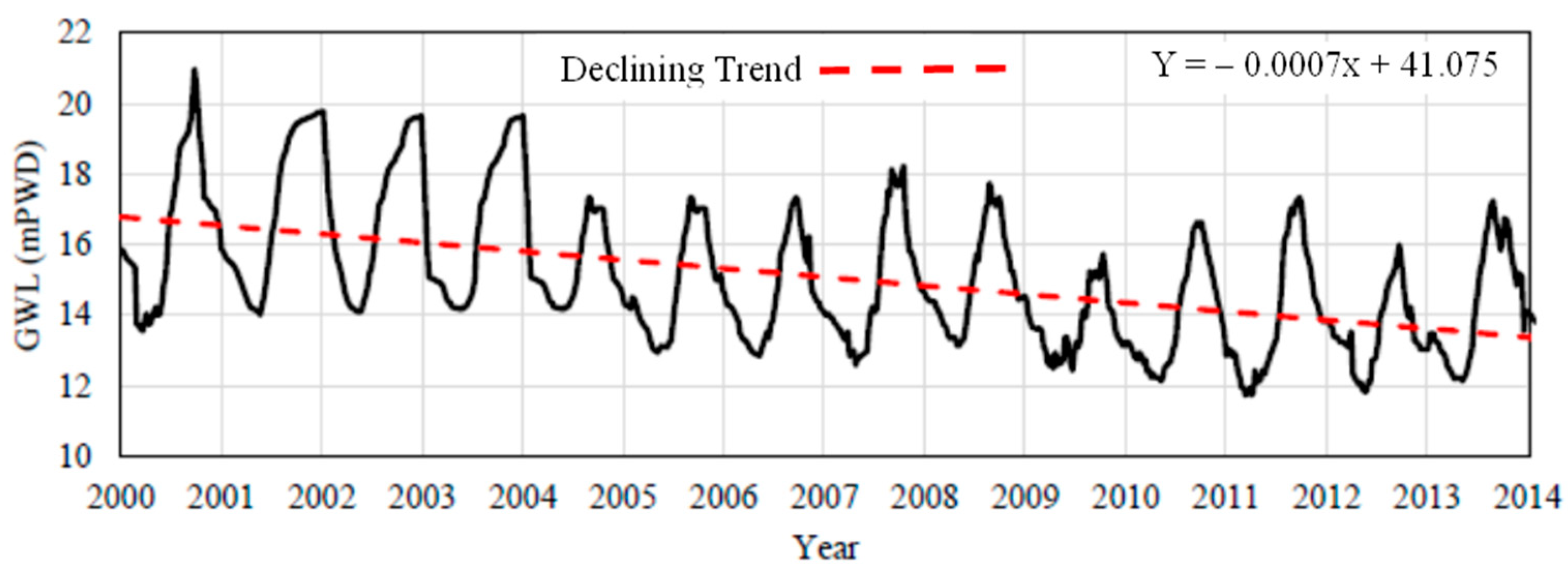

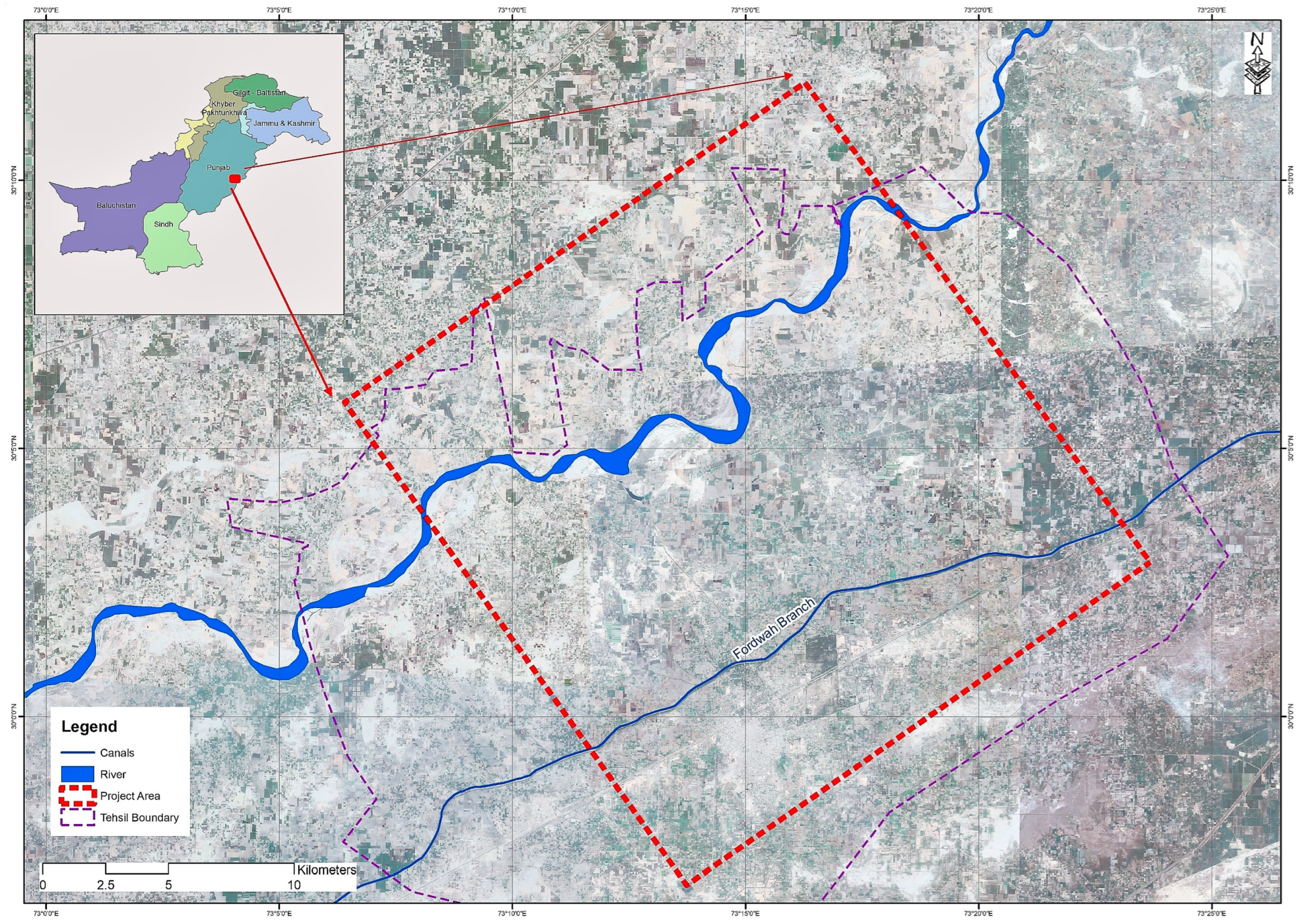
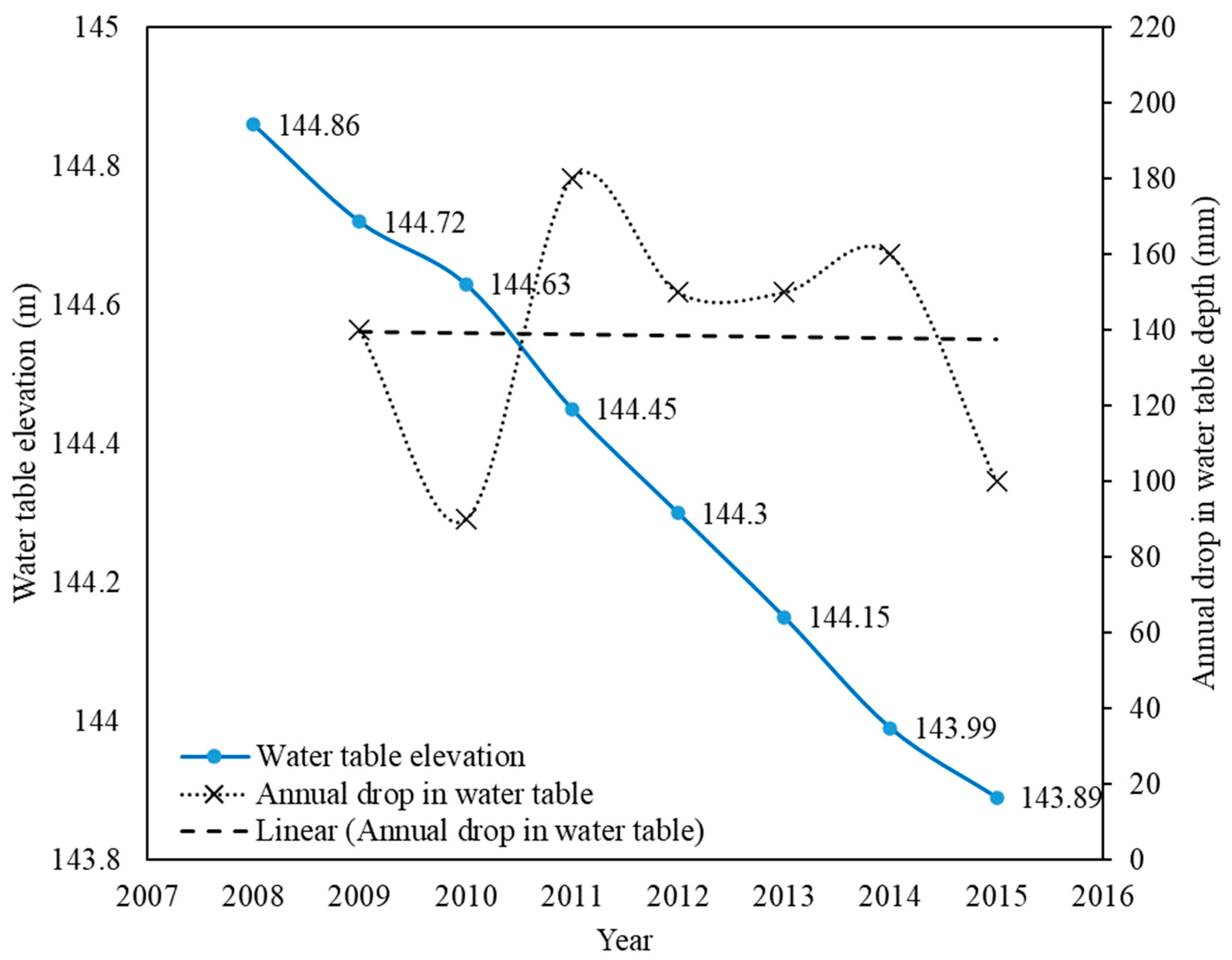

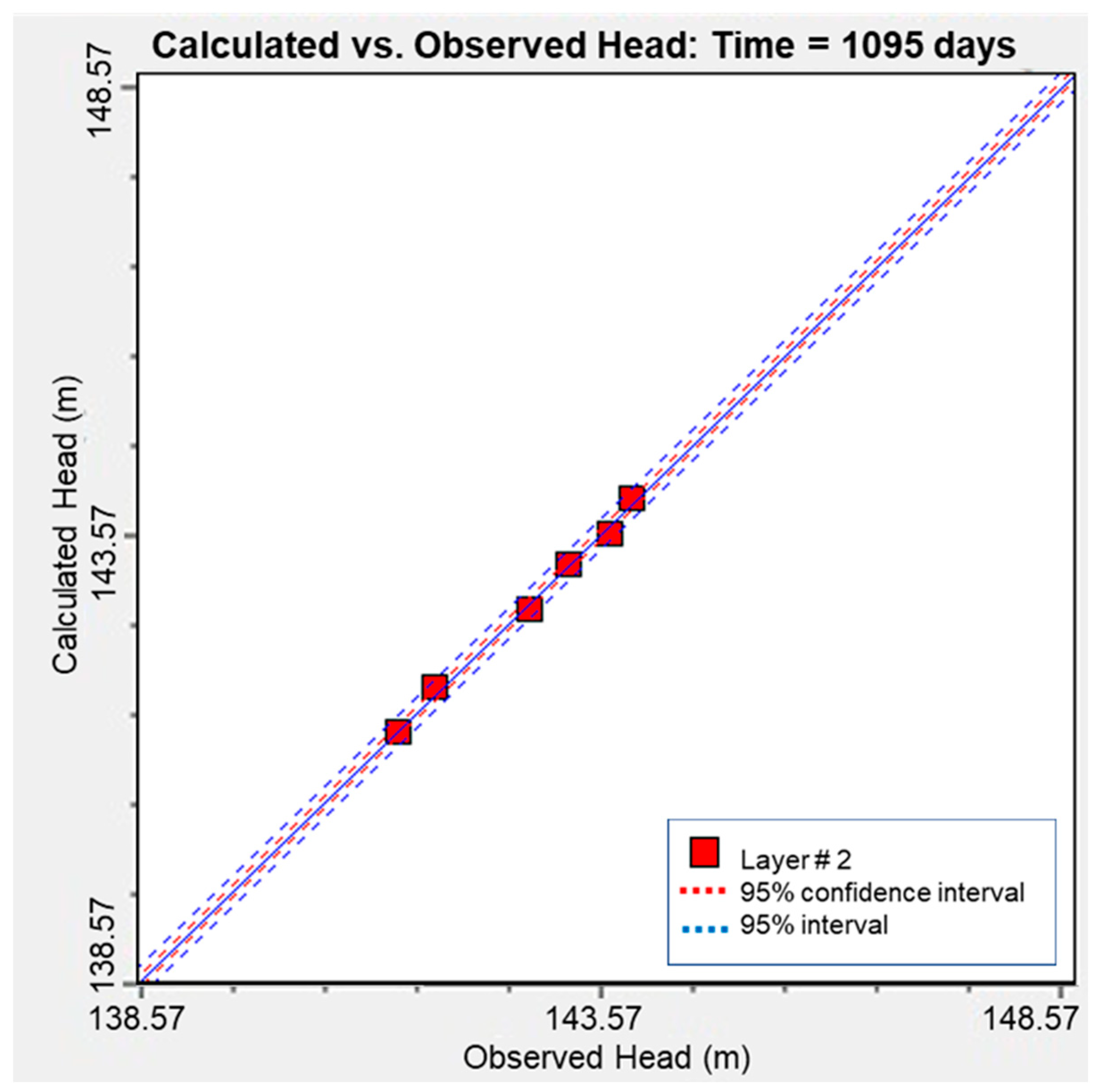
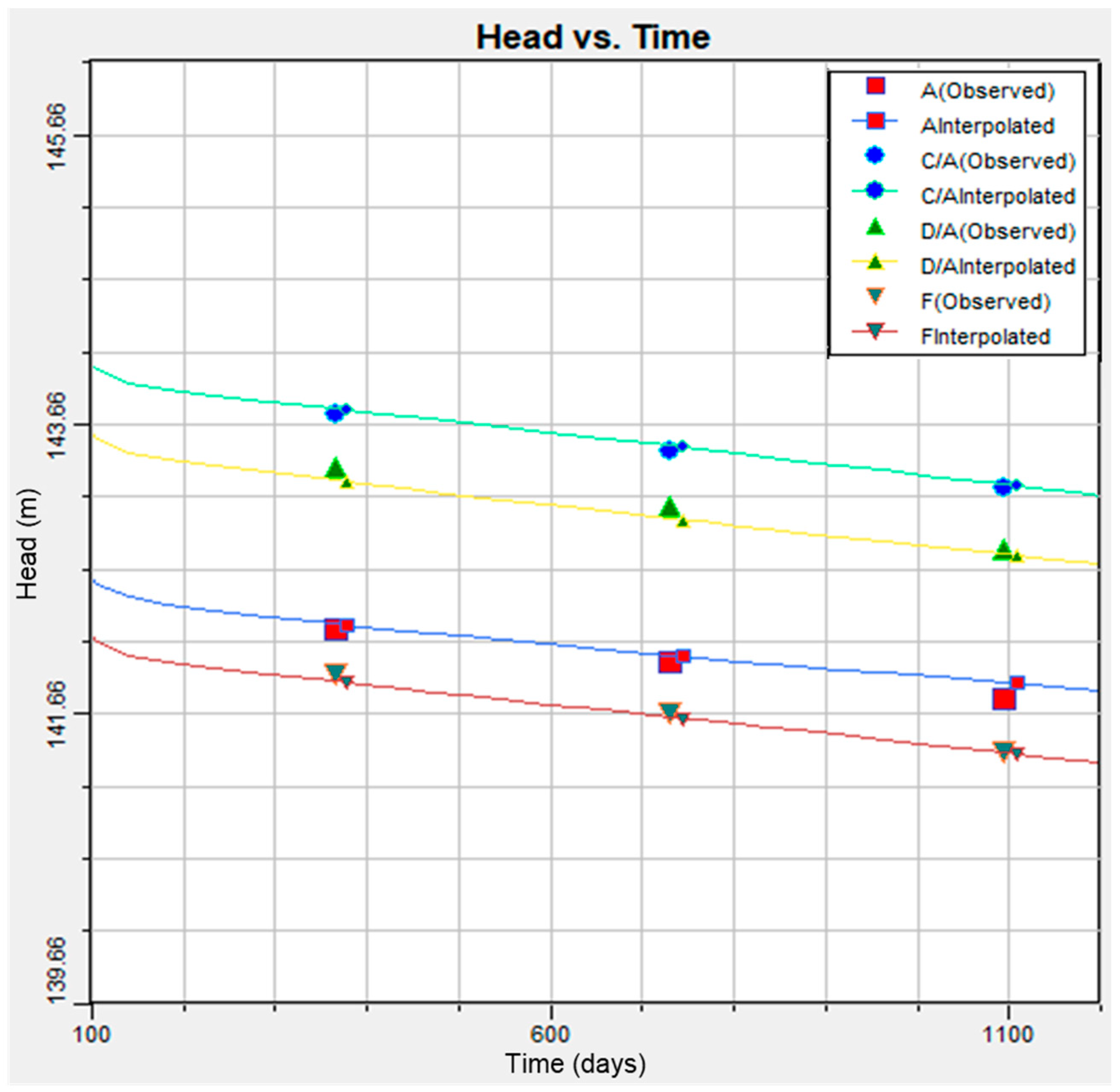
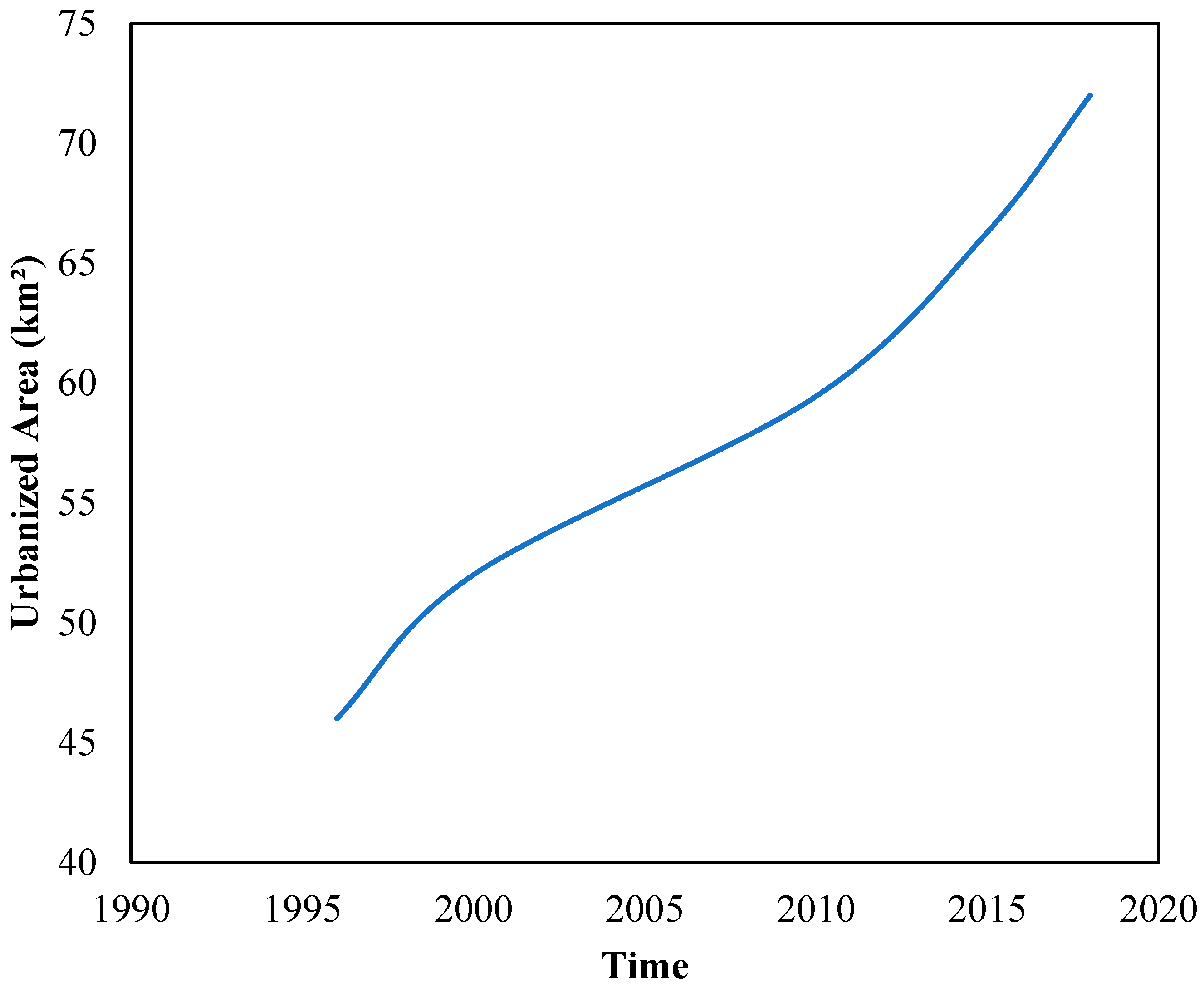
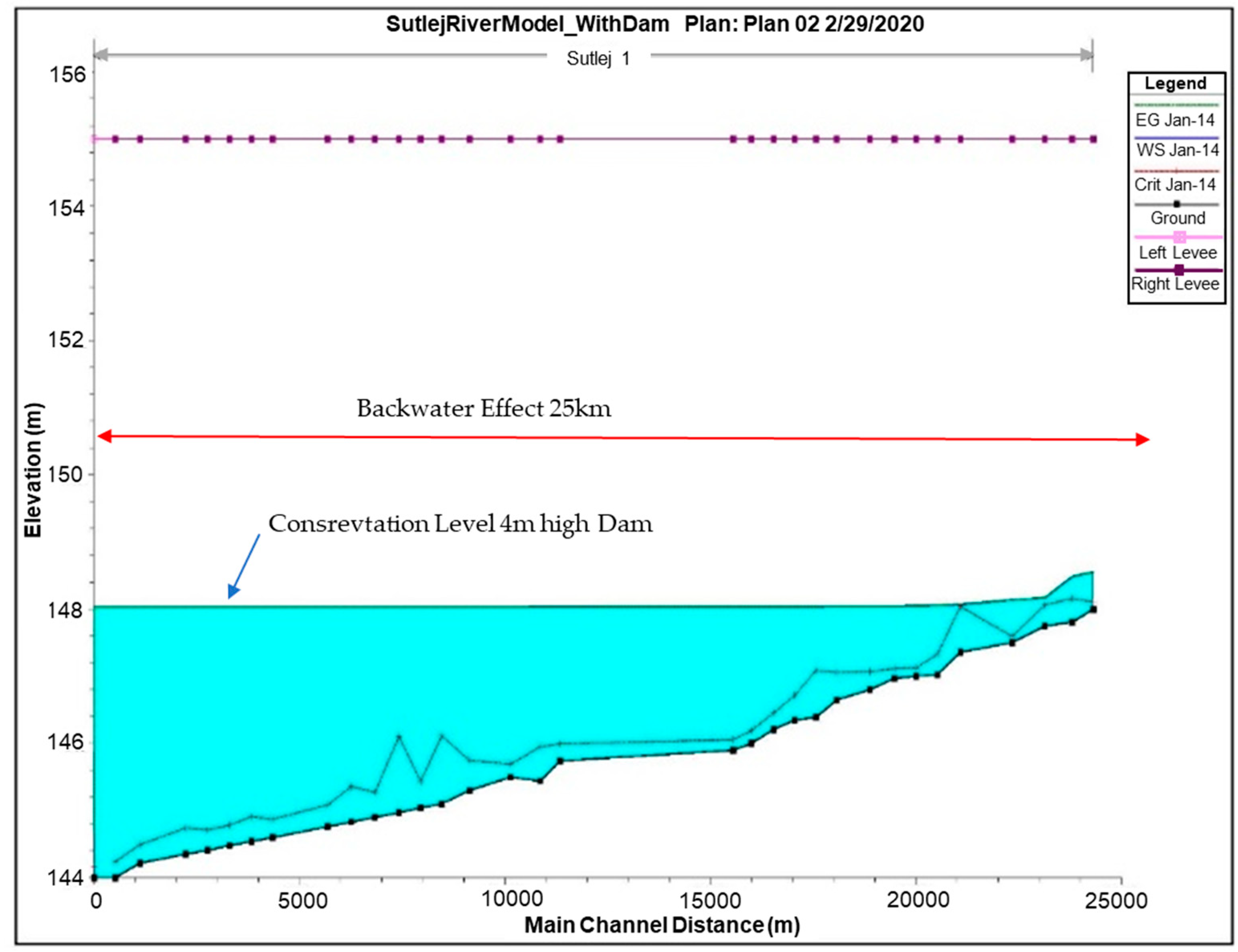
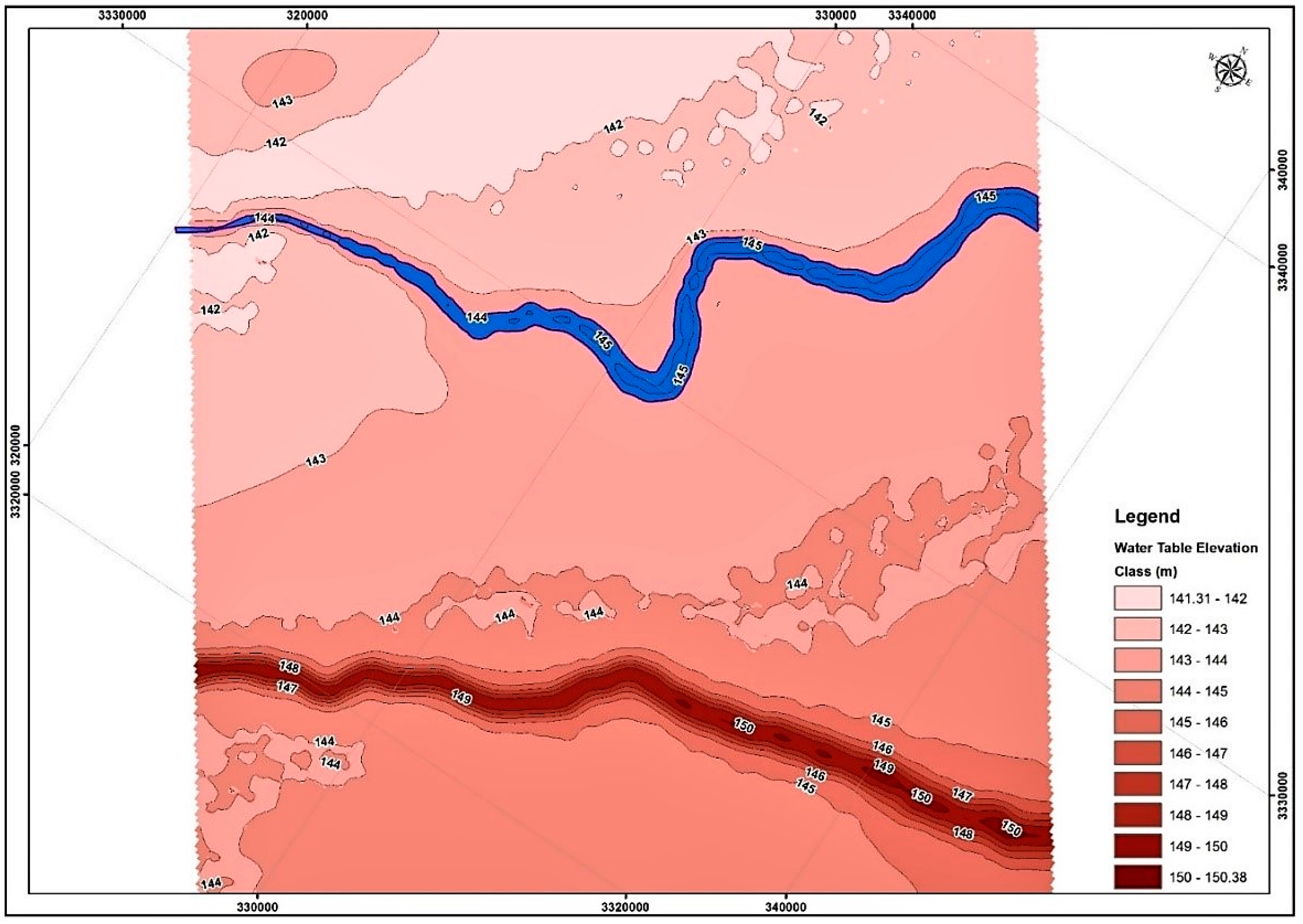
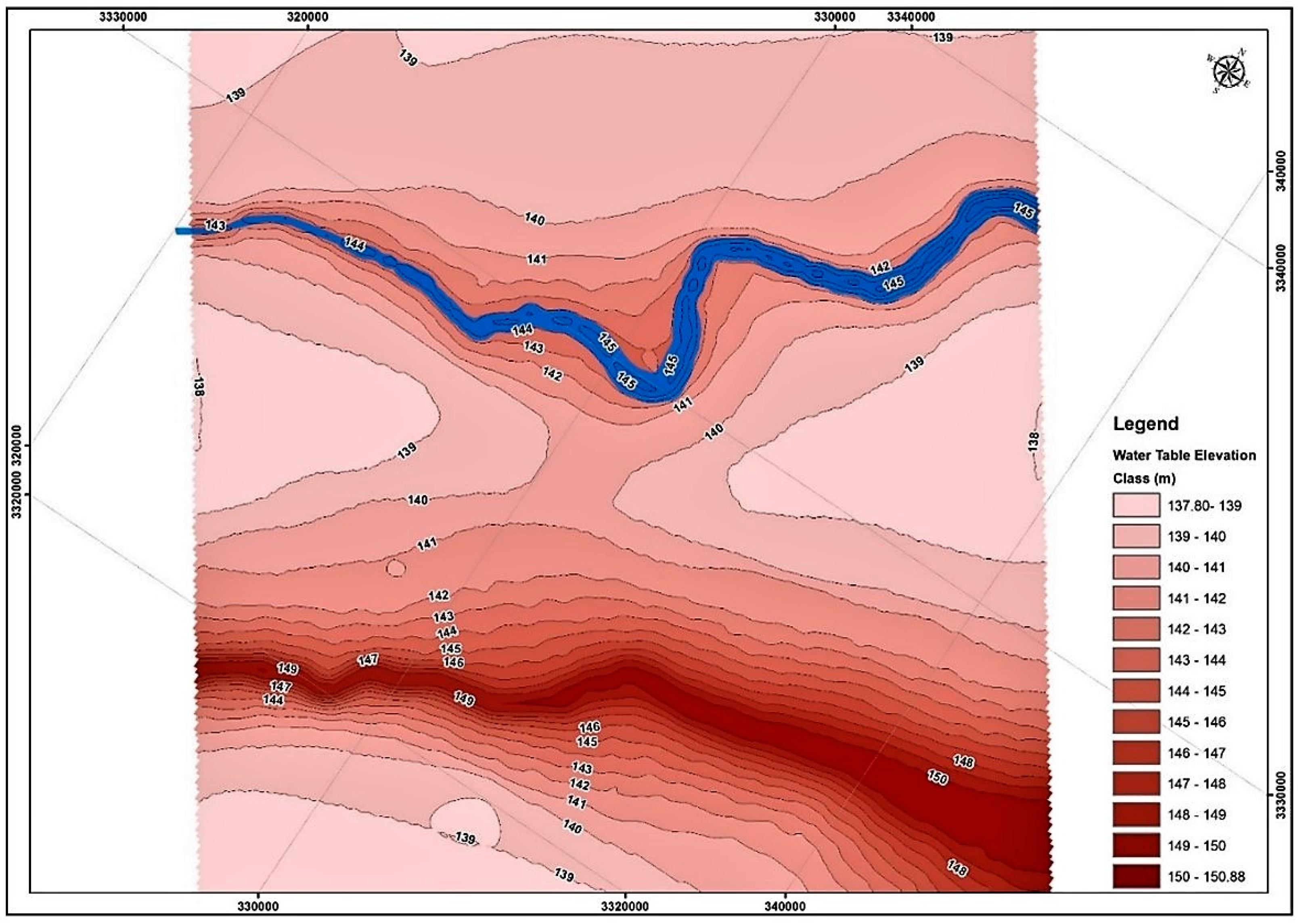
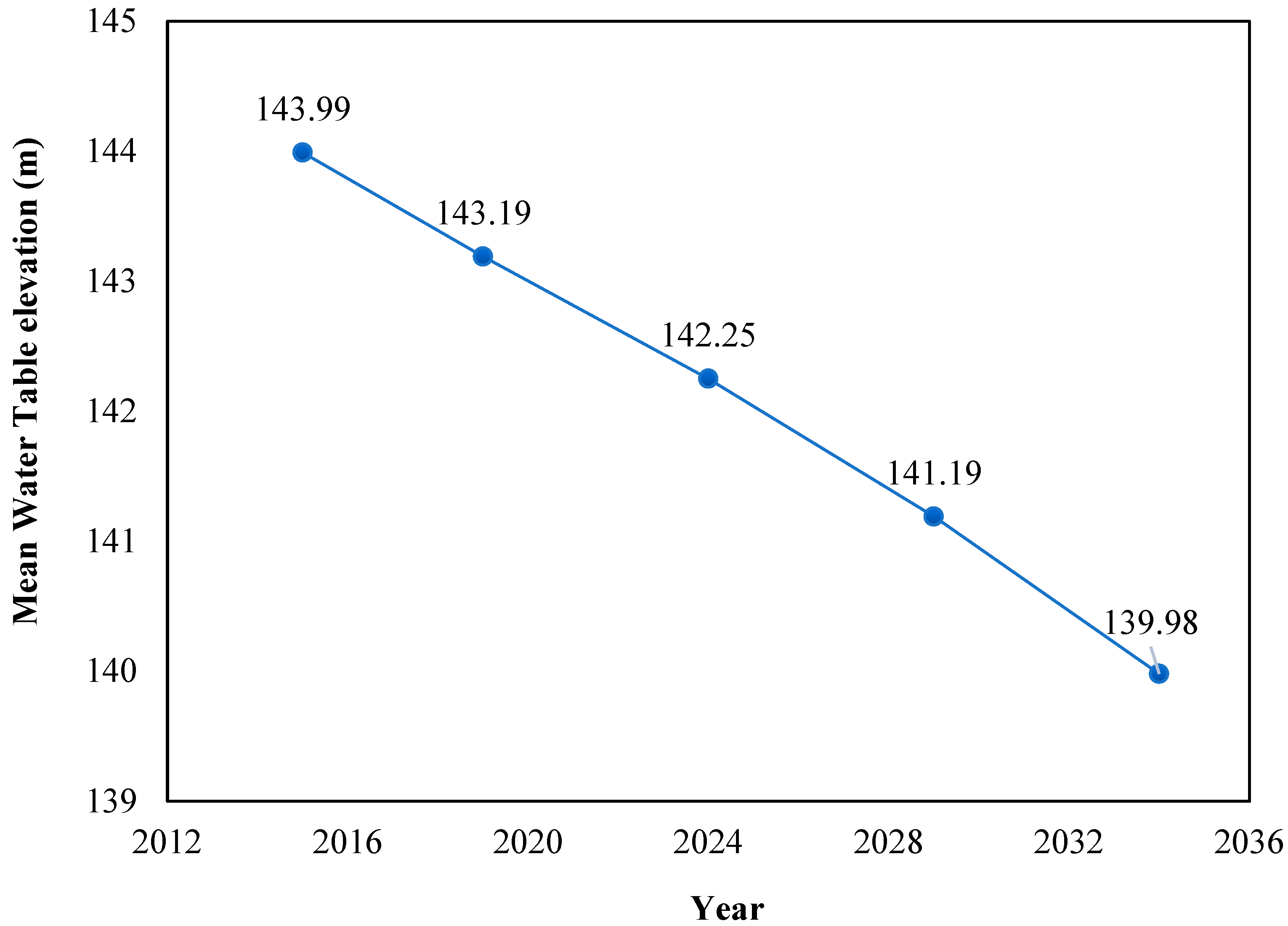
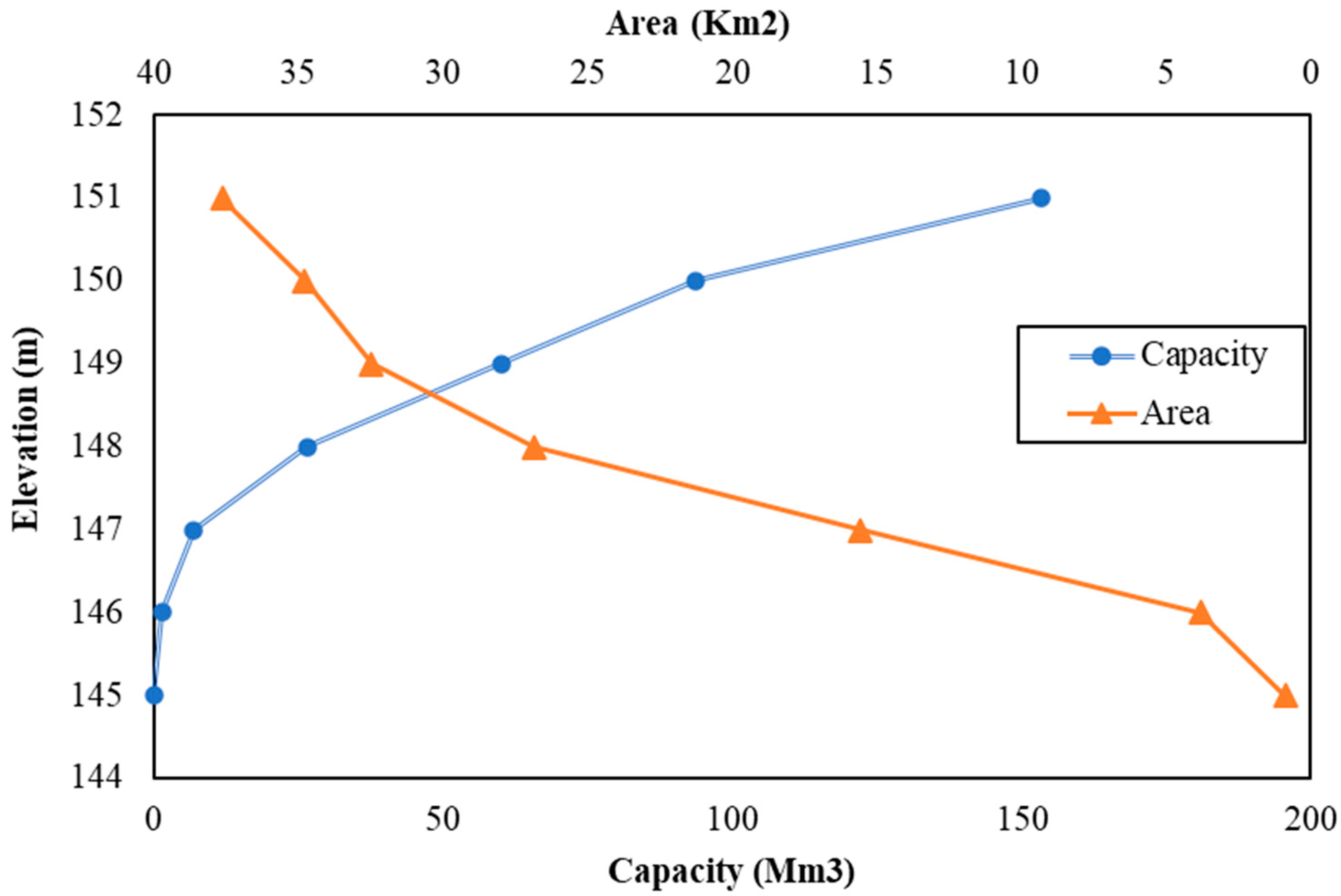
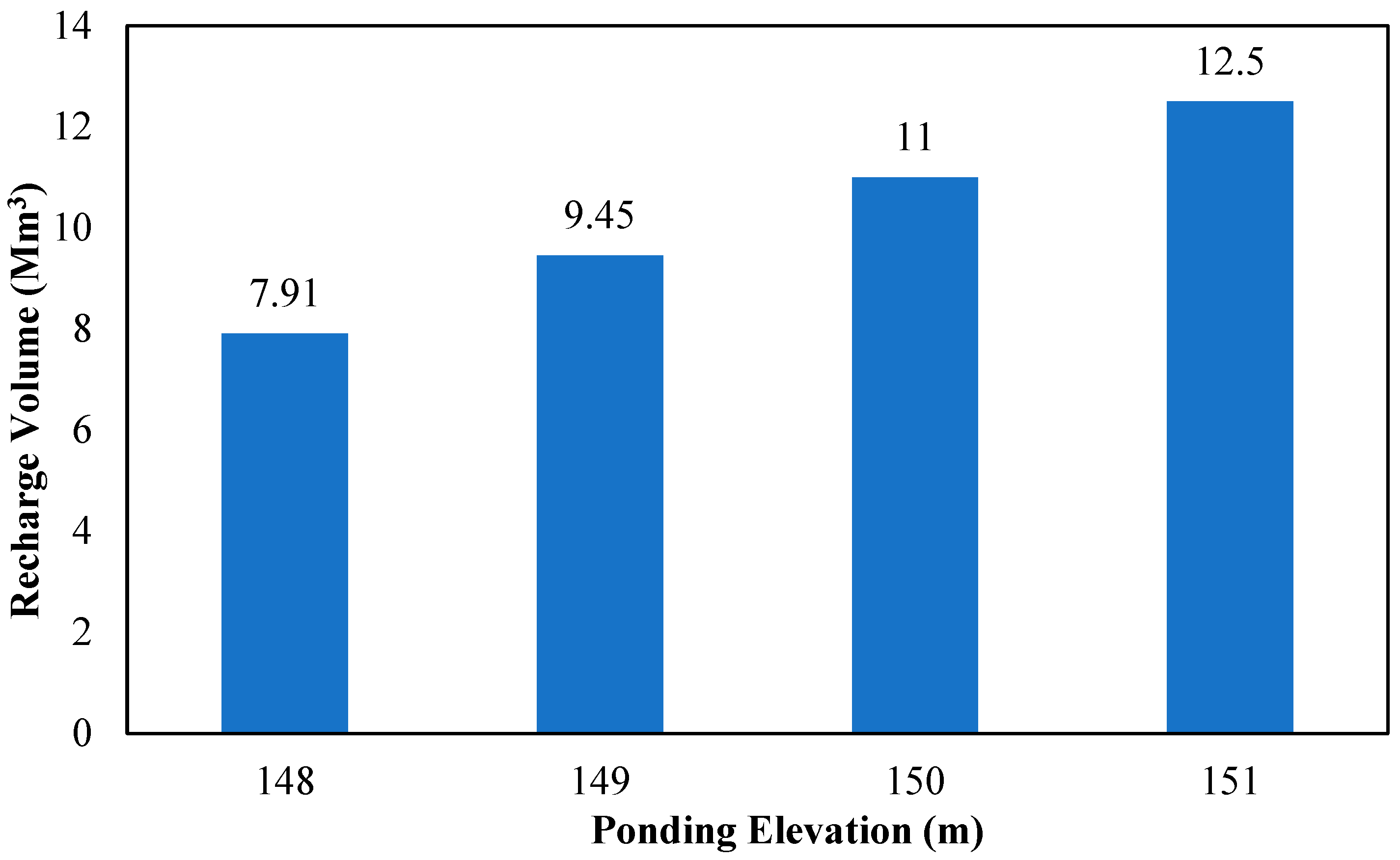
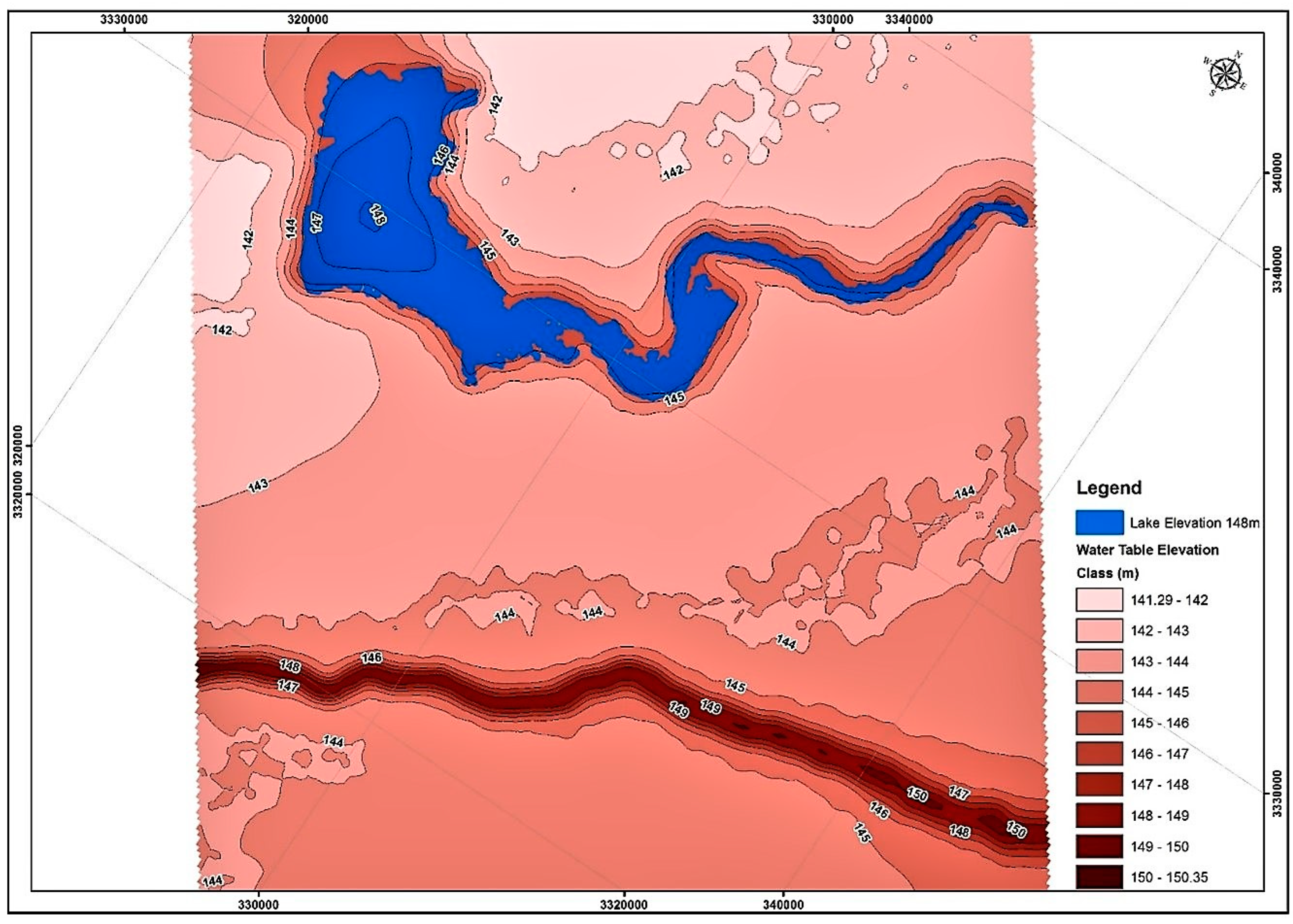
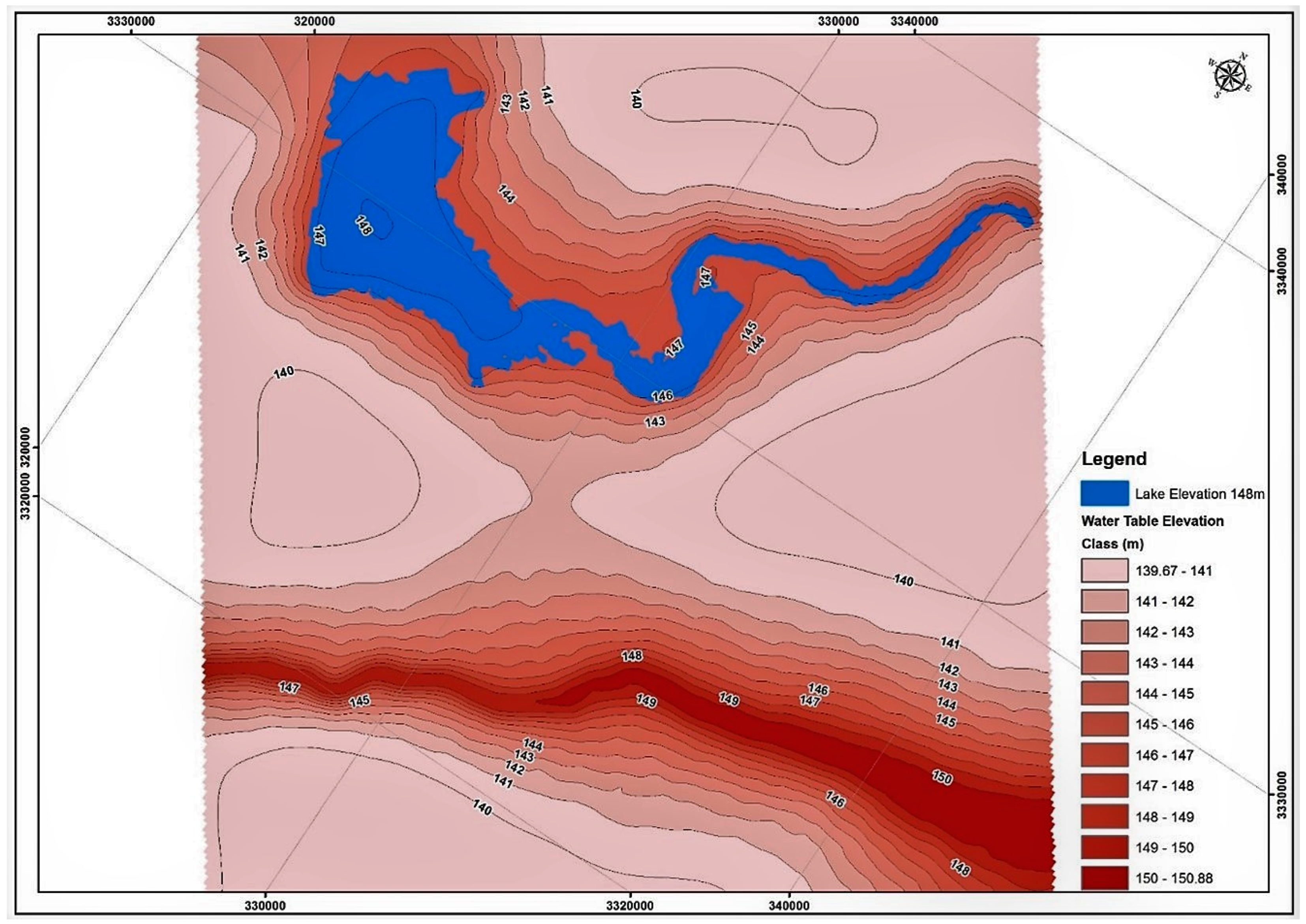
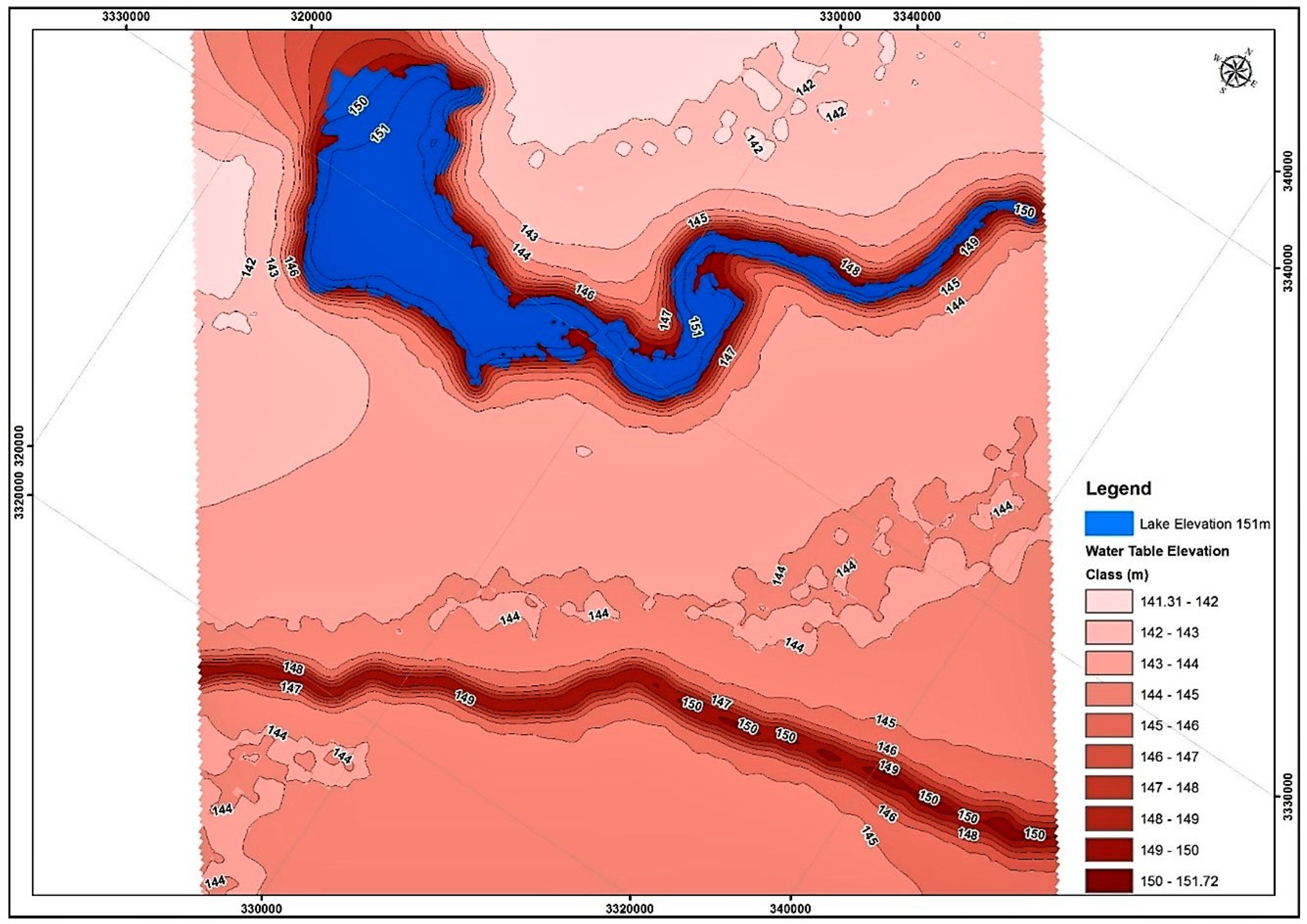
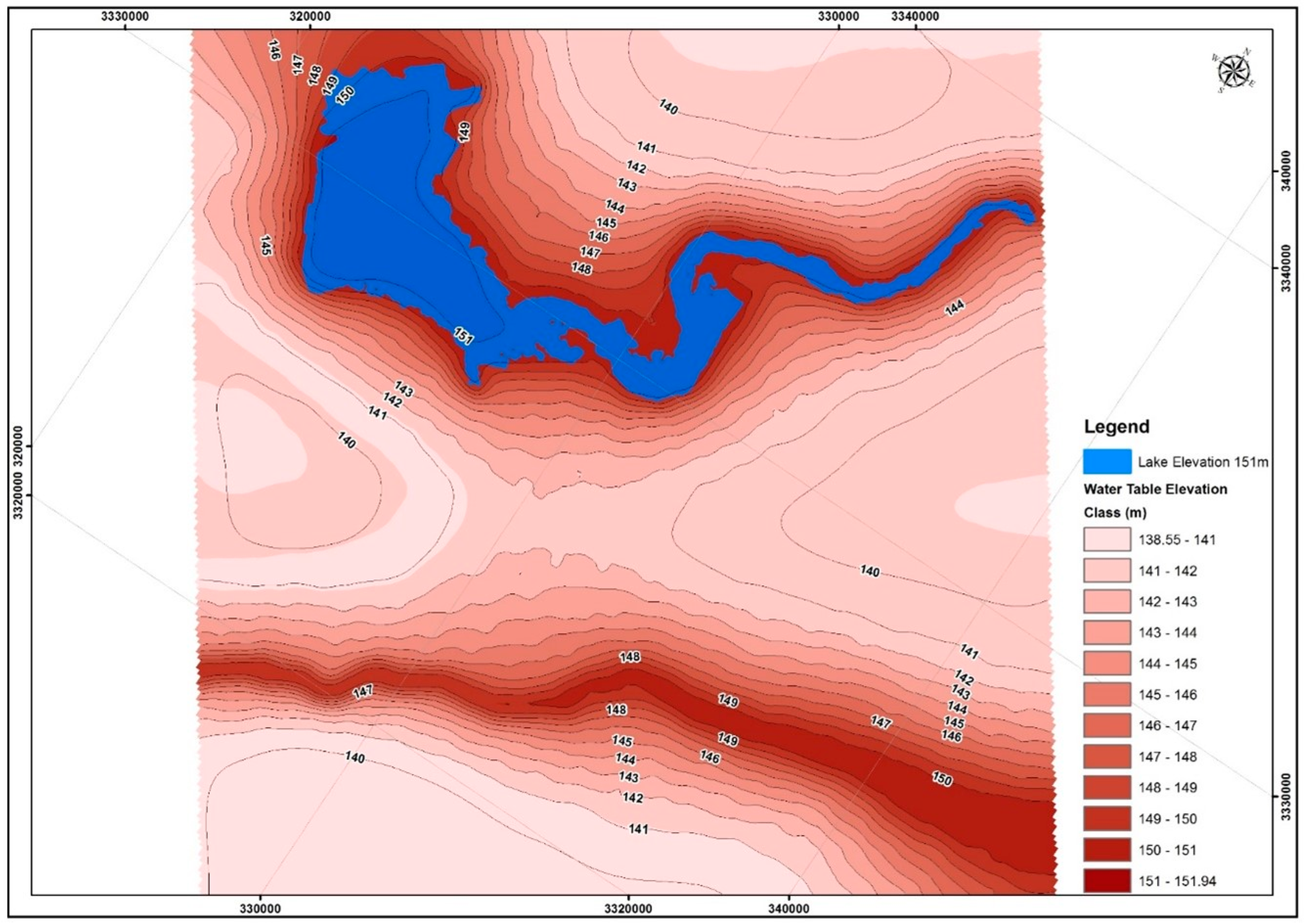
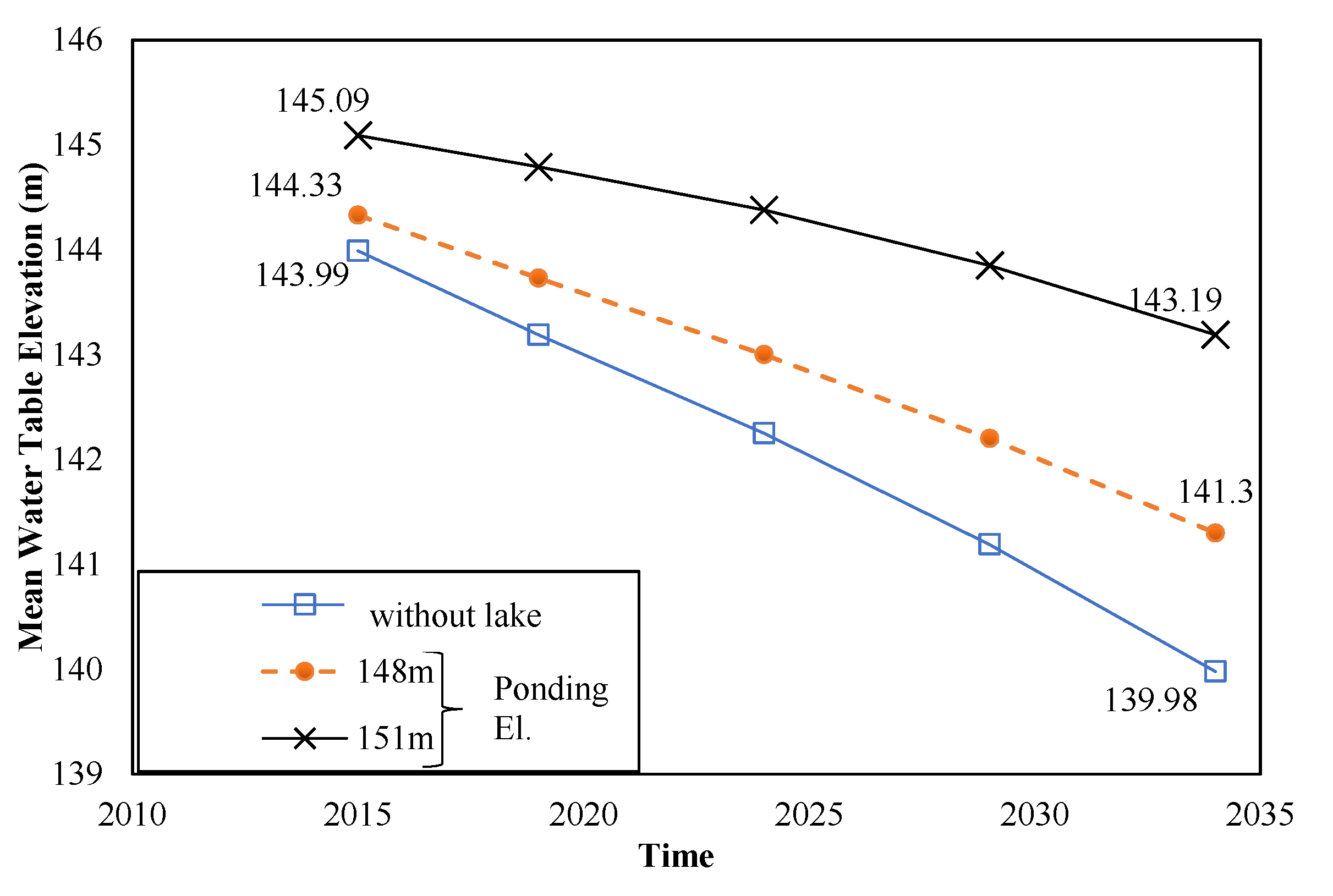
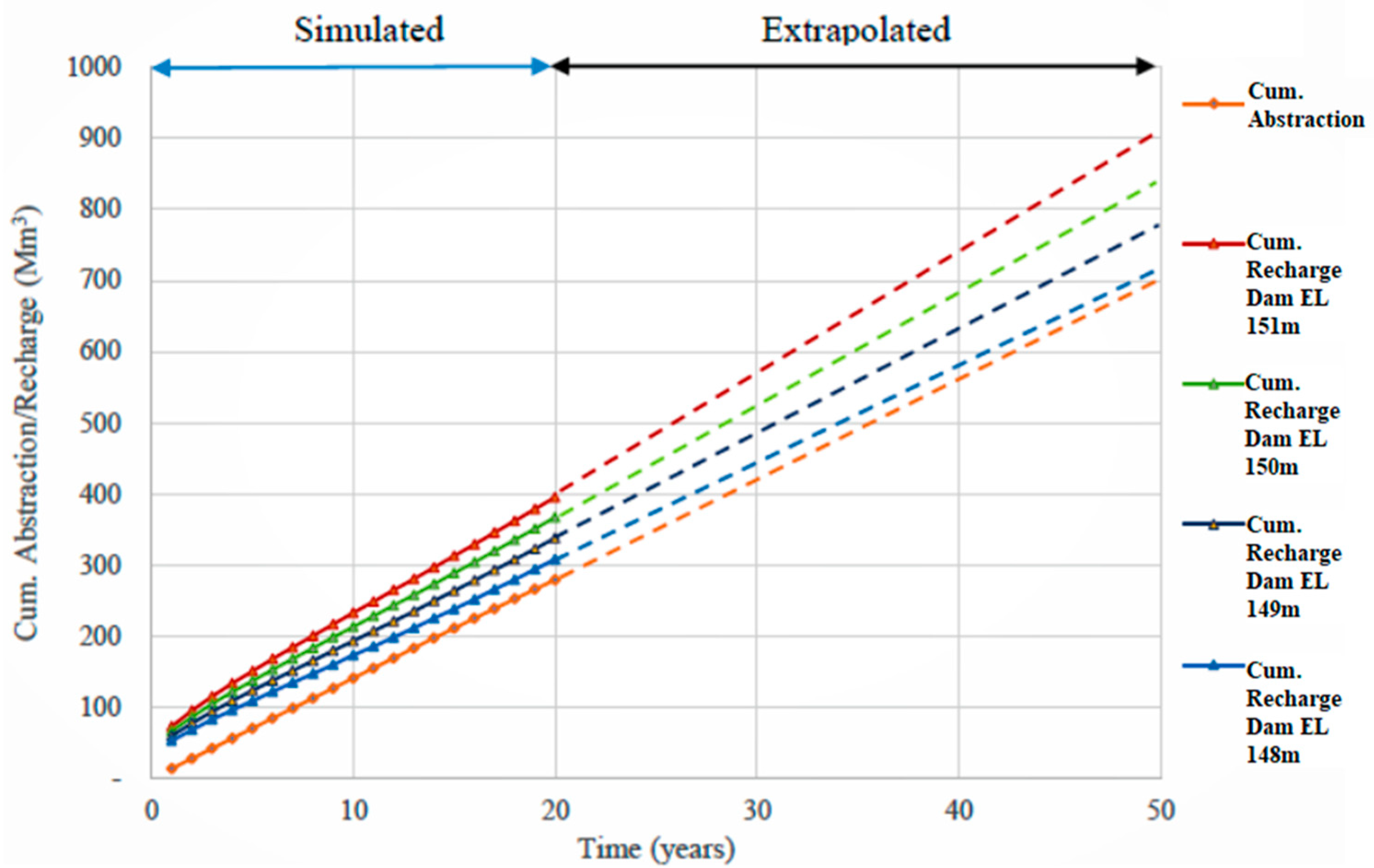
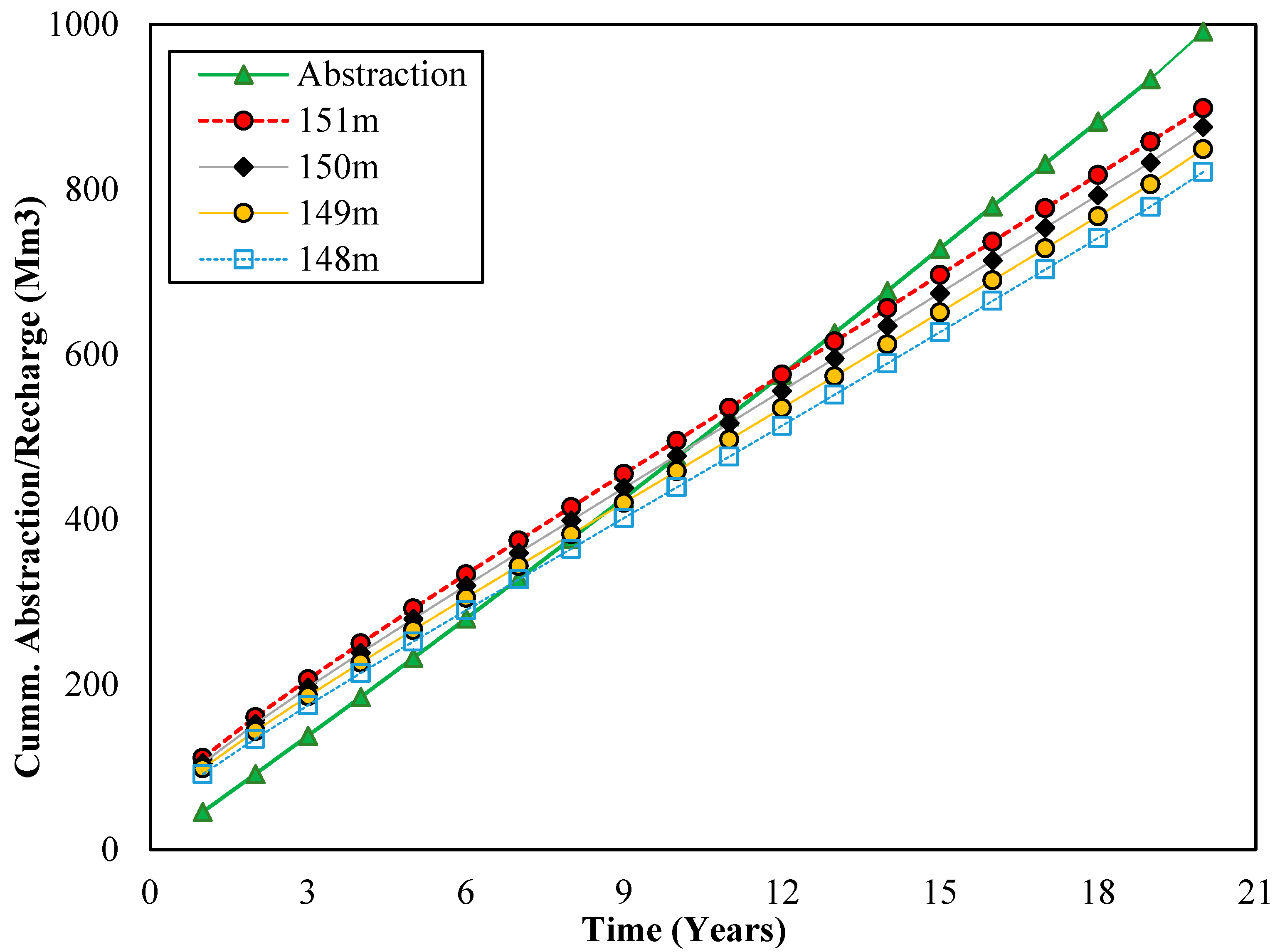
| Description | Layer 1 | Layer 2 |
|---|---|---|
| Depth (m) | 10 | 140 |
| Hydraulic Conductivity, K (m/s) | 1.95 × 10−7–6.8 × 10−6 | 1.1 × 10−5–1.35 × 10−5 |
| Specific Yield, Sy | 0.10 | 0.22 |
| Effective Porosity | 0.45 | 0.35 |
| Specific Storage, Ss (1/m) | 1 × 10−4 | |
| Elevation (m) | Height (m) | Lake Area (km2) | Lake Volume (Mm3) | Recharge Volume (MGD) |
|---|---|---|---|---|
| 148 | 4 | 26.8 | 26.52 | 7.91 |
| 149 | 5 | 32.5 | 60.07 | 9.45 |
| 150 | 6 | 34.8 | 93.71 | 11.00 |
| 151 | 7 | 37.6 | 153.32 | 12.50 |
Disclaimer/Publisher’s Note: The statements, opinions and data contained in all publications are solely those of the individual author(s) and contributor(s) and not of MDPI and/or the editor(s). MDPI and/or the editor(s) disclaim responsibility for any injury to people or property resulting from any ideas, methods, instructions or products referred to in the content. |
© 2023 by the authors. Licensee MDPI, Basel, Switzerland. This article is an open access article distributed under the terms and conditions of the Creative Commons Attribution (CC BY) license (https://creativecommons.org/licenses/by/4.0/).
Share and Cite
Mushtaq, F.; Rehman, H.; Ali, U.; Babar, M.S.; Al-Suwaiyan, M.S.; Yaseen, Z.M. An Investigation of Recharging Groundwater Levels through River Ponding: New Strategy for Water Management in Sutlej River. Sustainability 2023, 15, 1047. https://doi.org/10.3390/su15021047
Mushtaq F, Rehman H, Ali U, Babar MS, Al-Suwaiyan MS, Yaseen ZM. An Investigation of Recharging Groundwater Levels through River Ponding: New Strategy for Water Management in Sutlej River. Sustainability. 2023; 15(2):1047. https://doi.org/10.3390/su15021047
Chicago/Turabian StyleMushtaq, Fahad, Habibur Rehman, Umair Ali, Muhammad Salman Babar, Mohammad Saleh Al-Suwaiyan, and Zaher Mundher Yaseen. 2023. "An Investigation of Recharging Groundwater Levels through River Ponding: New Strategy for Water Management in Sutlej River" Sustainability 15, no. 2: 1047. https://doi.org/10.3390/su15021047
APA StyleMushtaq, F., Rehman, H., Ali, U., Babar, M. S., Al-Suwaiyan, M. S., & Yaseen, Z. M. (2023). An Investigation of Recharging Groundwater Levels through River Ponding: New Strategy for Water Management in Sutlej River. Sustainability, 15(2), 1047. https://doi.org/10.3390/su15021047







